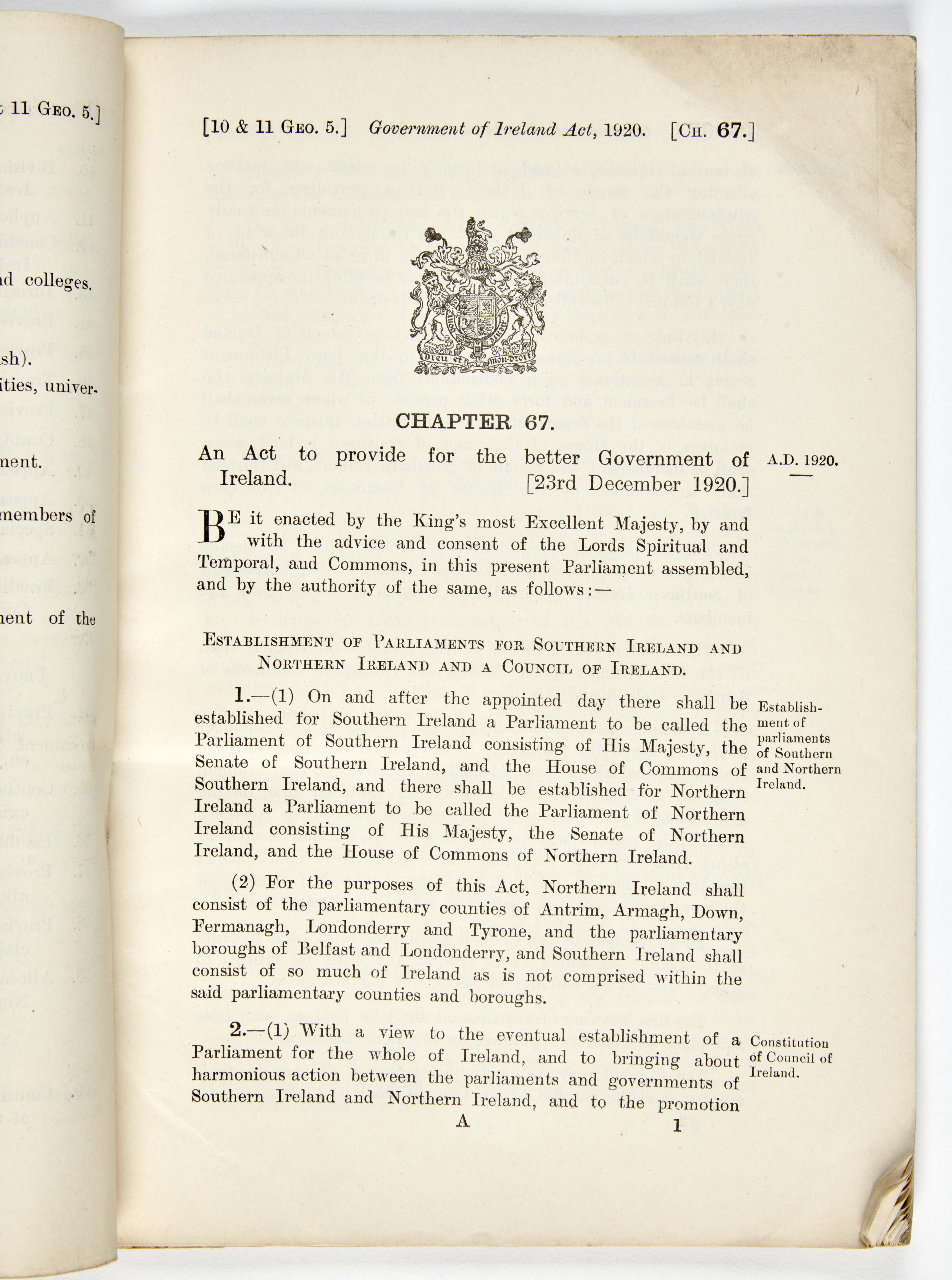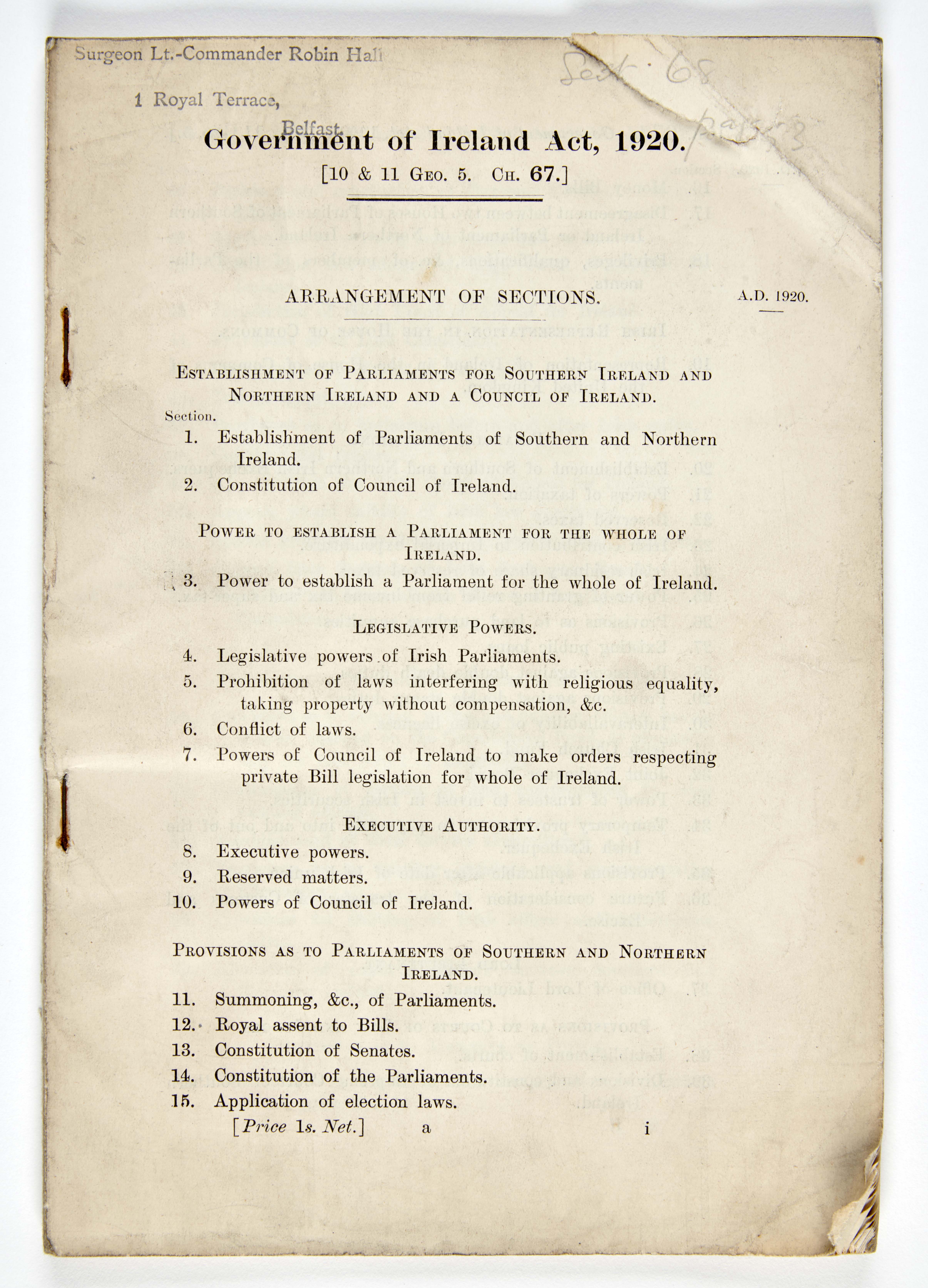

This was an Act of Parliament of the United Kingdom.
View on RequestAct Of Parliament produced by HMSO
This was an Act of Parliament of the United Kingdom.
It is the culmination of a long process of Bills that were presented to the Parliament,, over a number of Years, to deal with, and ultimately resolve, the question of Home Rule in Ireland.
The Act’s longer Title was described as:
“An Act to provide for the better government of Ireland”
Various attempts had been made to give Ireland limited self-government with a series of Home Rule Bills which had been presented, over a number of Years, for consideration by the UK Parliament.
This 1920 Act was the ultimate result of the Fourth Home Rule Bill, and ultimately passed into Law as The Government of Ireland Act 1920.
The purpose of the Act was to partition the 32 Counties of Ireland into two self governing territories, rather than two separate Countries:
The six North Eastern counties of Antrim, Armagh, Down, Fermanagh, Londonderry and Tyrone were to be formed into what was to be known as “Northern Ireland”.
Under it’s auspices the remaining 26 Counties were to form what was to be known as “Southern Ireland”.
Whilst both Northern and Southern Ireland were to receive a Parliament of their own under the Terms of the Act, with significant aspects of local government devolved to them, The Act intended, and provided for, that both were intended to remain within the "United Kingdom of Great Britain and Ireland”.
There were areas specifically reserved to the Parliament of the United Kingdom - chief amongst these were matters relating to the Crown, Defence, Foreign Affairs, International Trade and Currency.
It was intended that the local Parliaments, created by the Act, would have responsibility for only Local matters, such as Education, Housing and Health.
Many of the matters, which had been reserved by the UK Parliament, were intended to be transferred at a later date.
The Two Parliaments, North & South, were essentially linked by the Council of Ireland. Representatives from both were to be sent to the Council, to discuss matters of mutual concern, and interest. The intention of the UK Government was to allow the Council to work towards establishing a single Parliament, for the whole of Ireland.
The Fourth Home Rule Bill was passed and enacted by the Westminster Parliament in November 1920.
The Act received the Royal Assent from King George V on 23rd December 1920.
As it passed into Law it’s provisions were already out of step with the political realities in Ireland, which had been waging a War of Independence to secure full Independence from the United Kingdom.
The long standing calls, over decades, for Home Rule, essentially a limited degree of self government, had been replaced by calls for complete Independence - something which the Act simply did not provide for, or envisage.
The Terms of the Act set out that it’s provisions would come into force on 3rd May 1921. This date is the date which is now formally recognised as the birth date of Northern Ireland.
On 3rd May 1921 Northern Ireland was created, with provision for it’s own devolved Government, and provision for it’s continued place in the United Kingdom, on that basis.
Whilst Southern Ireland was created by the same Terms, with The Act coming into force, the majority of it’s Citizens, and it’s Politicians simply did not recognise the Country as such, preferring to recognise the self declared Irish Republic, which was manifest in the continuing Irish War of Independence, which continued to rage, even whilst the Acts Terms came into force on May 3rd.
In that regard the machinery created by The Government of Ireland Act in Southern Ireland was largely ignored. The Southern Parliament met just once in June 1921, was adjourned in July 1921, and ultimately dissolved in 1922.
The Act provided for the holding of fresh Elections, in both territories, in May 1921. It was provided that instead of the existing 105 MPs, across Ireland, within the UK Parliament, the fresh elections would return 33 MPs from Southern Ireland, and 13 MPs from Northern Ireland. The same Constituencies were to return 128 MPs to the Southern Parliament in Dublin, and 52 MPs to the Northern Parliament, in Belfast .
Elections for the two Parliaments took place in May 1921.
Dail Eireann refused to recognise the partitioning of the island, or the institutions created by the Act. It declared the May 1921 Elections as returning members to a second Dail Eireann, rather than the Southern Parliament. In that regard only 4 Unionist MPs attended the first sitting of the Southern Parliament, in June 1921.
The Parliament in Northern Ireland was Opened with great fanfare by King George V on 22nd June 1921, with a Speech that made a famous appeal for Anglo-Irish, and North-South reconciliation.
The Irish War of Independence continued, unabated, with unrest throughout Ireland, until a Truce ws brokered in July 1921 and protracted negotiations, leading to an Anglo Irish Treaty in December 1921.
That Treaty provided, in December 1922, for the creation of The Irish Free State.
The birth of the Irish Free State, in 1922, effectively meant, that South of the Border, the Government of Ireland Act had no practical effect after 1922, although it was not formally repealed, under Irish Law until 2007.
The Government of Ireland Act created various institutions of Government in Northern Ireland. These continued to function, until they were suspended, by the British Government, in 1972, with the resumption of Direct Rule.
What remaining provisions there were, of the Government of Ireland Act, were replaced by the provisions of 1998’s Good Friday Agreement.
Owned by Linen Hall Library. Images used by Permission of The Linen Hall Library